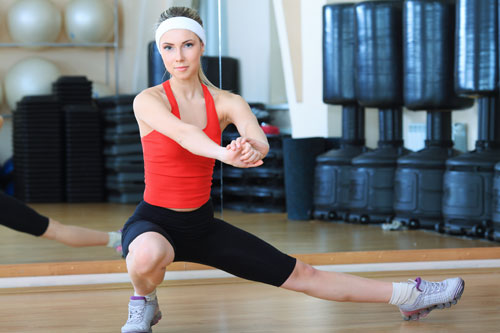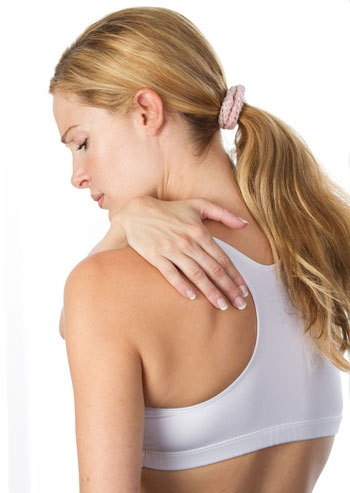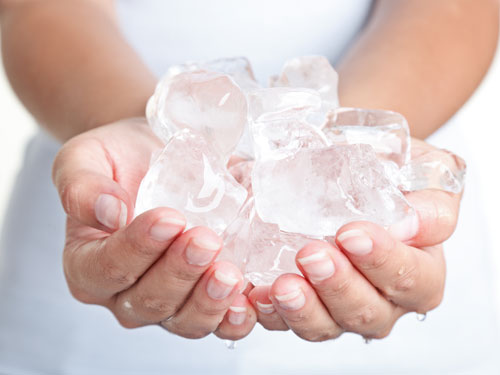Poor flexibility and mobility can greatly impair the quality of your movement. It is important to take steps to incorporate mobility training because it can affect not only your fitness goals, but your health in general.
Active Isolated Stretching
Whether you're a professional athlete or someone who's simply seeking to improve his or her fitness level, always bear in mind that stretching and mobility work is an important component of your exercise program.
There are a number of stretching techniques out there, but one of my personal favorites is Active Isolated Stretching (AIS) by Aaron Mattes, a registered kinesiotherapist and rehabilitation therapist. Here's a quick demonstration of how to do AIS.
To learn more on how this technique works, watch my lecture on Active Isolated Stretching.
Using the Power Plate
Some people struggle with staying in shape because of their priorities — they "don't have enough time" for exercise. To address this problem, I suggest doing my Peak Fitness program, which includes a 20-minute high-intensity workout.
But I didn't stop there. I have discovered an efficient technology that can boost your Peak Fitness efforts and enable you to train like an athlete in less than 90 minutes per week: the Power Plate®.
The Power Plate® in no way replaces my Peak Fitness workout, but instead enhances it. It uses Whole Body Vibrational Training, which uses vibration to engage 98 percent of your muscle fibers, including your fast and super-fast muscle fibers, with less weight and time.
The Power Plate® functions by vibrating in three dimensions: vertical, horizontal, and sagittal (front to back). When exposed to these vibrations, each of your muscles automatically reacts and contracts. The motion is very similar to an earthquake; only the Power Plate® moves very quickly (about 25 to 50 times per second) across very small distances (1 to 2 millimeters). With each direction the Power Plate® vibrates, you gain a certain benefit:
- Up and down vibrations improve your muscle tone.
- Left and right vibrations improve your balance and coordination.
Working out with the Power Plate® can result in a dramatic improvement in your strength and power, flexibility, balance, and tone. Vibrational exercises are known to help you achieve:
- Improved blood circulation
- Increased muscle strength and flexibility
- Enhanced range of motions
- Increased bone density
- Reduced appearance of cellulite
- Reduced muscle pain and soreness
- Quicker recovery from injury
Mobility Training With Foam Rolling
Sometimes, the simplest activities can provide immense benefits, and foam rolling is one good example of this. Therapists and athletes use foam rollers to mimic myofascial release treatments, which work to help reduce muscle pain and immobility. You can also use other tools like lacrosse balls to improve tissue mobility.
Foam rolling is sometimes compared to getting a massage, because as you do it, your fibrous tissue is broken down and circulation is boosted. This is the mechanism by which foam rolling relieves tension and pain. You can also use foam rollers to work out "knots" or trigger points in your muscles.
You can do foam rolling both before and after exercise, but keep this in mind: if foam rolling during a pre-workout session, focus on problem areas, but if performed during post-workout, focus on all muscle groups worked during that day. In this video, fitness trainer Jill Rodriguez demonstrates foam rolling techniques for your entire body.
Injury Prevention
Lifting Safely: Reaching Your 'Goldilocks Zone'

During strength training, many people commit the mistake of pushing themselves too hard or using weights that are too light. In addition, here are other errors some people commit when they lift weights. Take note, these actually lead to injury.1
- Skipping warm-up — Sprains and tears can occur if you work cold, stiff muscles. It is important to perform a dynamic warm-up before every lifting session.
- Using a poor and sloppy form — As I've said before, form is very important: stand straight, look forward, keep your abs tight, and keep your knees over your second toe.
- Putting stress on your shoulders — Performing too many exercises wherein your elbows are pulled behind your body can strain the connective tissue in front of the joints. Make sure you don't let your elbows extend more than 2 inches behind your body.
- Neglecting opposing muscle groups — Strength imbalances can increase the chances of injury. Remember that, for every exercise that works the front of your body, you will need to do an exercise that will target your rear.
In order to achieve maximum benefits from lifting, you need to strive for your "Goldilocks zone," where you're pushing hard enough to challenge your body at your current level of fitness.2
Over time, this will change and you need to increase the intensity of your workout. Until then, take note that it makes no difference how heavy your weights are, just as long as you achieve muscle failure and fatigue after a number of repetitions. More specifically, the weight you're working with should not be so heavy that you cannot complete the set within one or two minutes.3
Common Workout Mistakes

While exercise provides outstanding health benefits, it is also one of the first things that many people don't see through the end, despite their best intentions. As published in Shape magazine, here are some of the most common workout mistakes, as well as my recommendations for avoiding them:4
Should You Work Out While You're Sick?

Generally, it is wise to avoid exercise when you're feeling under the weather. However, there is evidence to support that moderate exercise, like walking, can work wonders in fighting the virus in your system. The key is to listen to your body and make sure that you don't overdo your exercise. As a general guideline, it's usually okay to exercise when the symptoms are "above your neck" (provided you do so with low to moderate intensity):5
- Runny nose
- Nasal congestion
- Sneezing
- Sore throat
- Headache
Increasing your body temperature by means of sweating will enhance your body's ability to kill viruses. On the other hand, it is better to avoid exercise if you have symptoms "below the neck:"
- Fever
- Coughing or chest congestion
- Fatigue
- Widespread body and muscle aches
- Vomiting, upset stomach, and/or stomach cramps
No matter what your symptoms are, exercise only if you have the energy for it, because over-exercising will only stress your body and suppress your immune system as a result. It also boosts the production of the stress hormone cortisol, which inhibits the activity of natural killer cells or white blood cells that attack viral agents.
Another great tool that can be used to determine if you have recovered enough from personal stressors or exercise would be heart rate variability monitoring which can be done relatively inexpensively.
Hot and Cold Therapies

Applying ice or heat can provide relief from injuries, aches, and pains, but they shouldn't be used interchangeably. Generally speaking, ice works well after a sudden injury while heat helps to soothe ongoing muscle aches and pains.
Cryotherapy
After participating in athletics, doing a workout, or simply doing house chores, your muscles may get stiff and sore. For some individuals, the pain does not occur immediately, but within 24 hours after the activity. This pain is called delayed-onset muscle soreness (DOMS).
A warm shower may be ideal for this situation, as warm water can promote blood flow to your skin, which can help soothe aching muscles. However, there is evidence showing that cold water can offer better pain relief. Cryotherapy or cold water immersion is a popular technique among amateur and professional athletes because it helps speed up recovery time and reduces muscle inflammation and soreness after exercise.
A cold-water bath can do more than relieve muscle discomfort; it can also support your metabolism and fat-burning ability. According to Dr. Ray Cronise, you can boost your fat-burning potential by as much as 300 percent by adding ice therapy to your diet strategy.
To learn more about Ice Therapy, read my article "Muscle Soreness — Is Cold Water Immersion an Effective Treatment?" Additionally, Cronise has done some fascinating work in cold thermogenesis and alternating warm and cold showers. His protocols can be found by searing on the internet.
Gel Packs
However, cryotherapy may not be for everyone. Instead of doing this full-body approach, you may try a targeted method instead, such as applying gel packs to specific areas of your body. While this won't completely give you relief from muscle soreness, it can be very beneficial for a pulled muscle or an injury.
Cold treatments should be used for the first 48 to 72 hours. Apply the cold gel pack for 20 minutes and then remove for 20 minutes, as this will lower the risk of any potential damage. An alternative to gel packs is ice. When you choose to use ice, make sure you use a cloth or towel wrap.
Gel packs can also be used for hot therapy. Gel packs come in handy and are easy to use, but make sure to know what it's made of. Some packs are filled with toxic chemicals that can eventually leak.
Saunas
One important benefit people experience when taking a sauna is deep-sweating. Many people don't actively sweat despite their busy lifestyles. It is best to use infrared saunas as they seem to work the best. Just be sure that they are ones that have ceramic panels that have low EMF. Here are just some of the many benefits you can get from taking a sauna:
- Stress relief — Saunas can provide you with a quiet place to unwind and relax.
- Heart health and longevity — Regularly spending time in a sauna may help keep the heart healthy and extend life. Researchers from the University of Eastern Finland tracked 2,300 middle-aged men for an average of 20 years. They found that the more sessions per week men spent in the sauna, the lower their risk of sudden cardiac death and fatal coronary heart disease. The sauna also extended the life of participants with other illnesses, including cancer.
- Relieve muscle soreness — High temperatures — like the cold — can help soothe aching muscles.
- Detoxification — Deep-sweating can help your body eliminate unwanted toxins from your body.
- Skin cleansing — When you sweat, you help cleanse your skin's epidermal layer and sweat ducts.
- Better sleep — Sauna baths can help you relax, enabling you to sleep better at night.
- Social benefits — Sauna baths provide a relaxing environment for you to socialize with family and friends.
- Athletic Recovery — Growth hormone is crucial for repair and recovery of muscles, and research has shown that two 20-minute sauna sessions separated by a 30-minute cooling period elevated growth hormone levels two-fold over baseline. Two 15-minute sauna sessions at an even warmer temperature separated by a 30-minute cooling period resulted in a five-fold increase in growth hormone.
-
Muscle Gain and Fat Loss — Bigger biceps or a more toned butt by reading a magazine while sweating profusely? It could happen. Sauna conditioning can lend itself to promoting muscle growth and fat loss by improving insulin sensitivity and decreasing muscle protein catabolism.
Intermittent hyperthermia has been shown to reduce insulin resistance in obese mice, and in this case insulin-resistant diabetic mice were subjected to 30 minutes of heat treatment, three times a week for twelve weeks. The results were a 31 percent decrease in insulin levels and a significant reduction in blood glucose levels, both of which can contribute to an increase in muscle growth and an increase in weight control and fat loss.
- Immune System Boost — Studies have shown the effect of sauna use on the immune system, specifically white blood cell profile, cortisol levels and selected physiological indices in athletes and non-athletes. The subjects from both a sauna group and a control group participated in 15-minute sauna sessions until their core temperature rose by 1.2 degrees Celsius.
-
Better Sleep — Next time you find yourself struggling with a bout of insomnia, try this trick: about two to three hours before bed, hunt down a gym sauna and get your sweat on for about 15 to 30 minutes. Next, hop in a lukewarm or cool shower for five to 10 minutes to bring your body temp down.
If you’ve got plenty of time on your hands, you can do this two to three times through. Researchers have found that a sauna can help provide a deeper, more relaxed sleep, and also relief of chronic tension, and relief of chronic fatigue issues.
- Increased Stress Resilience — Multiple research studies have shown that hyperthermia conditioning via the use of a sauna can prevent protein degradation and muscle loss by triggering the production of heat shock proteins (HSPs), which are then used by your cells to counteract potentially harmful stimulus, including environmental stress from pollutants, toxins, heat, cold, exercise stress and more.